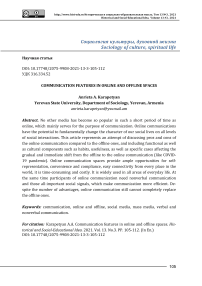Communication features in online and offline spaces
Автор: Karapetyan Anrieta A.
Журнал: Историческая и социально-образовательная мысль @hist-edu
Рубрика: Социология культуры, духовной жизни
Статья в выпуске: 3 т.13, 2021 года.
Бесплатный доступ
No other media has become so popular in such a short period of time as online, which mainly serves for the purpose of communication. Online communications have the potential to fundamentally change the character of our social lives on all levels of social interactions. This article represents an attempt of discussing pros and cons of the online communication compared to the offline ones, and including functional as well as cultural components such as habits, usefulness, as well as specific cases affecting the gradual and immediate shift from the offline to the online communication (like COVID-19 pandemic). Online communication spaces provide ample opportunities for self-representation, convenience and compliance, easy connectivity from every place in the world, it is time-consuming and costly. It is widely used in all areas of everyday life. At the same time participants of online communication need nonverbal communication and those all-important social signals, which make communication more efficient. Despite the number of advantages, online communication still cannot completely replace the offline ones.
Communication, online and offline, social media, mass media, verbal and nonverbal communication
Короткий адрес: https://sciup.org/149136766
IDR: 149136766 | DOI: 10.17748/2075-9908-2021-13-3-105-112
Список литературы Communication features in online and offline spaces
- Aralova E. Soznanie v kontekste virtual'nogo mira [Consciousness in the context of the virtual world]. Vlast' = Power. 2011. № 3. Pp. 2-7. (In Russian).
- Atanesyan A.V. Aktual'nye problemy sovremennyh politicheskih i konfliktnyh Kommunikacij [Actual problems of modern political and conflict communications]. Er. EGU. = Yerevan, YSU. 2008. Pp. 9-20. (In Russian).
- Babin E.N., Red'ko N.V., Redko N.V. Cocial'nye seti kak veb-servis v organizacii obrazovatel'nogo processa v VUZe// Informacionnaja sreda vuza XXI veka [Social networks as a web service in the organization of the educational process in the university // Information environment of the university of the XXI century]. Petro-zavods. Petrozavodskij gosudarstvennyj universitet = Petrozavodsk: Petrozavodsk State University. 2011. Pp. 1-5. (In Russian).
- Bubas G. Computer Mediated Communication Theories and Phenomena: Factors that Influence Collaboration Over the Internet. University of Zagreb, Faculty of organization and informatics, Croatia. 2001. Available at: https://cuc.carnet.hr/cuc2001/papers/b1.pdf [accessed 15 december. 2020]. Pp. 2-14.
- Van Aken N. Transformation of Online Friendships into a Real-Life Context in Individuals with Social Anxiety-Development and Application of the Need to Transfer Scale. Vienna 2015. Pp. 9-25. DOI:10.13140/RG.2.2.15384.65284.
- Gluhov A.P., Kuzheleva-Sagan I.P., Bulatova T.A., Bychkova M.N. i dr. Social'nye seti kak infrastruktura mezhlichnostnogo obshhenija cifrovogo pokolenija: transformacija frejmov kommunikacii [Social Networks as an Infrastructure for Interpersonal Communication of the Digital Generation]. kollektivnaja monografija. Tomsk. Izdatel'skij Dom Tomskogo gosudarstvennogo universiteta = collective monograph. Tomsk. Publishing House of Tomsk State University. 2017. Pp. 51-70. ISBN978-5-94621-654-8. Available at: https://core.ac.uk/download/pdf/287425645.pdf [accessed 14 may. 2021]. (In Russian)
- Kamaljan A. Osobennosti leksiki kommunikacij v internete, nauchnaja konferenci-ja, posvjashhjonnaja 130-letiju so dnja rozhdenija Grigora Kapancjana [Features of the vocabulary of communications on the Internet, scientific conference dedicated to the 130th anniversary of the birth of Grigor Kapantsyan]. 2017. Pp. 389-400. (In Armenian).
- Karr N. The Shallows: What the Internet is doing to Our Brains. W.W. Norton & Company. New York London, 2011. Pp. 150-166.
- Krombhol'c K., Merkl D., Weippl E. Fake Identities in Social Media: A Case Study on the Sustainability of the Facebook Business Model. The Society of Service Science and Springer 2012. Available at: https://publications.sba-research.org/publications/krombholzetal2012.pdf [accessed 14 May.2020]. Pp. 175-186.
- Liberman A., Shreder Dzh. Two social lives: How differences between online and offline interaction influence social outcomes. University of California, San Diego. Rady School of Business. Available at: https://escholarship.org/content/qt94n9w8b9/qt94n9w8b9_noSplash_293949a5 e051fffc8e1fdcc9ffc168c4.pdf?t=qdtezb&fbclid=IwAR2PDbo2oOEgTIJV5tb8wOoxY qWYRMi8yak2_3H8Kx4gEtJp4lxua1jhh0 [accessed 18 December. 2020]. Pp. 17-19. (In English).
- Lopes A.G., Kuarteros K.G. Exploring the Effects of Social Media on Interpersonal Communication among Family Members. Canadian Journal of Family and Youth 12(1). 2019. Pp. 66-70. doi:10.29173/cjfy29491.
- Mennecke B. E., Triplet J.L., Hassall L.M., Conde Z. et al. An Examination of a Theory of Embodied Social Presence in Virtual Worlds. IOWA State University. N5. 2011. Available at: https://core.ac.uk/download/pdf/194083594.pdf [accessed 02 February. 2020]. Pp. 20-30.
- Morrison-Smit S., Ruis Dzh. Challenges and barriers in virtual teams: a literature review. SN Applied Sciences. 1096(2). 2020. Available at: https://link.springer.com/article/10.1007/s42452-020-2801-5 [accessed 15 may. 2020].
- Tajer S. Je., Sukan'ja R. Predpochtenija onlajn-obshhenija v zavisimosti ot vozrasta, pola i prodolzhitel'nosti ispol'zovanija Interneta [Online Communication Preferences across Age, Gender, and Duration of Internet Use]. Kiberpsihologija i povedenie = CyberPsychology & Behavior. 9(4) 2006. DOI: 10.1089/cpb.2006.9.432. Pp. 432-440.
- Tonton Ju. How has COVID-19 affected the way we communicate? 2020. Available at: https://www.uab.edu/news/research/item/11542-how-has-covid-19-affected-the-way-we-communicate [accessed 16 January. 2020].
- Utari P. Adhiarso D.S. The Impact of Digital Technology to Change People's Behavior in Using the Media. UGM digital press, Social sciences and humanities 2018(2). DOI:10.29037/digitalpress.42256. Pp. 38-43.
- Chendler V. Technological or Media Determinism. 2013. Available at: https://www.wolearn.org/pluginfile.php/45/mod_page/content/33/chandler2002_PDF_full.pdf [accessed 18 January. 2021]. Pp. 16-28.
- Chernjaeva K. O. Globalizacija, potreblenie, virtualizacija kak kul'turnye konteksty identichnosti [Globalization, consumption, virtualization as cultural contexts of identity]. Izvestija Saratovskogo universiteta = Bulletin of the Saratov Universi-ty.Vol. 10. Ser. Sociology. Political Science.vol. 2. 2010. Pp. 56-59. (In Russian).
- Chzhou X., Zafarani R. A Survey of Fake News: Fundamental Theories, Detection Methods, and Opportunities. ACM.Computer. Survey 1(1). 2020. Available at: https://arxiv.org/pdf/1812.00315.pdf [accessed 12 May. 2021]. https://doi.org/10.1145/3395046. Pp. 3-14.


